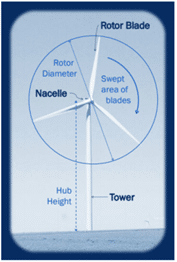Project Overview
The proposed Red Brick Energy Project is located approximately 20 kilometres south of Foam Lake. The anticipated maximum generation capacity is 200 MW generated by up to 50 wind turbines. We chose the Project location after careful consideration, due to exceptional land partners and local support, the wind resource, and a suitable connection point to the SaskPower transmission system.
We are committed to working closely with local government and community members, and we strive to keep all parties informed. Your voice counts and your opinion matters to us. We have included a link to email our project team below for you to share feedback, questions or suggestions about the Project.
Project location
The map shows a general Project area within which the turbines are planned to be located. The exact locations of turbines are dependent on many factors, including environmental studies and community input.
Economic Benefits
If we are successful and the Project secures a PPA with SaskPower, we anticipate the Project will have an immediate positive economic impact with ongoing benefits over the 25-year project life. New revenues to the local economy will include municipal taxes, landowner payments, and local economic activities. We estimate that the Project will contribute approximately $25 million in property tax income locally over the life of the PPA, which is an estimated $1 million annually to be used by your community.
Construction of the Project will also bring employment opportunities to the area. Local contractors, service providers, equipment rentals, suppliers, and other area businesses will all be given preference wherever possible. Your area can also anticipate an increase in town activities and a local economic boost during the development phase of the Project, specifically for businesses in hospitality and services, including restaurants, short-term housing, and grocery stores.
Community Benefits
In addition to the economic benefits, the Project will also sponsor a number of local programs to support the community and provide additional benefits as an appreciation for hosting our Project in your area. We are currently reviewing several opportunities with the Foam Lake RM 276 administration team and council. The final program and community benefit package will be determined together with the leaders from your community. Options currently under consideration include:
- Post-secondary bursaries for qualifying graduating high school students from the area
- Educational tours of the Project for all levels of the school system
- Installing monitoring stations at local schools to help educate about renewable electricity production
- Partnering with local high-school trade programs to provide co-op options for local students
- Supporting or partnering with local and provincial governments on re-training programs
- Working with experts to plant vegetation in the vicinity of the Project that will support the population of local honey bees and other beneficial insects
We would love to hear your thoughts on the above and any other ideas you may have for community programs. Please use the ‘Contact the Red Brick Project Team’ button to submit any suggestions or feedback on the above.

When the wind blows, the blades of the wind turbine generate lift which turns the rotor, spinning a generator inside the nacelle and generating electricity. Modern wind turbines range anywhere from 100 to 125 metres in hub height, and each of the 3 blades can range between 60 and 80 metres in length. Each foundation, or “Turbine Pad,” typically takes up to one acre of land.
The wind turbines are connected by an underground electrical collector system that meets at the substation. The electricity is then converted to the correct voltage and exported to the SaskPower transmission system for people to use.
Each turbine will have its own access road. Depending on the location of the turbines, each access road may span 30 to 700 metres in length from a main or range road to the Turbine Pad. Each Access Road is typically 6 metres in width.
Temporary laydown and storage areas, a permanent operations and maintenance building, and upgrades of local roads may also be required.